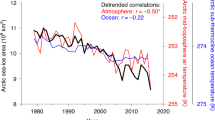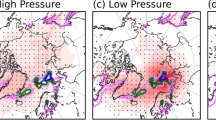Abstract
Possible future changes in Arctic sea ice cover and thickness, and consequent changes in the ice-albedo feedback, represent one of the largest uncertainties in the prediction of future temperature rise1,2. Knowledge of the natural variability of sea ice thickness is therefore critical for its representation in global climate models3,4. Numerical simulations suggest that Arctic ice thickness varies primarily on decadal timescales3,5,6 owing to changes in wind and ocean stresses on the ice7,8,9,10, but observations have been unable to provide a synoptic view of sea ice thickness, which is required to validate the model results3,6,9. Here we use an eight-year time-series of Arctic ice thickness, derived from satellite altimeter measurements of ice freeboard, to determine the mean thickness field and its variability from 65° N to 81.5° N. Our data reveal a high-frequency interannual variability in mean Arctic ice thickness that is dominated by changes in the amount of summer melt11, rather than by changes in circulation. Our results suggest that a continued increase in melt season length would lead to further thinning of Arctic sea ice.
This is a preview of subscription content, access via your institution
Access options
Subscribe to this journal
Receive 51 print issues and online access
$199.00 per year
only $3.90 per issue
Buy this article
- Purchase on Springer Link
- Instant access to full article PDF
Prices may be subject to local taxes which are calculated during checkout



Similar content being viewed by others
References
Carson, D. J. Climate modelling: Achievements and prospects. Q. J. R. Meteorol. Soc. 125, 1–27 (1999)
Rind, D., Healy, R., Parkinson, C. & Martinson, D. The role of sea ice in 2 × CO2 climate model sensitivity: Part II: hemispheric dependencies. Geophys. Res. Lett. 24, 1491–1494 (1997)
Battisti, D. S., Bitz, C. M. & Moritz, R. E. Do general circulation models underestimate the natural variability in the Arctic climate? J. Clim. 10, 1909–1920 (1997)
Houghton, J. T. et al. Climate Change 2001: The Scientific Basis (Cambridge Univ. Press, 2001)
Hilmer, M. & Lemke, P. On the decrease of Arctic sea ice volume. Geophys. Res. Lett. 27, 3751–3754 (2000)
Polyakov, I. V. & Johnson, M. A. Arctic decadal and interdecadal variability. Geophys. Res. Lett. 27, 4097–4100 (2000)
Zhang, J. L., Rothrock, D. & Steele, M. Recent changes in Arctic sea ice: The interplay between ice dynamics and thermodynamics. J. Clim. 13, 3099–3114 (2000)
Zhang, Y. X. & Hunke, E. C. Recent Arctic change simulated with a coupled ice-ocean model. J. Geophys. Res. 106, 4369–4390 (2001)
Chapman, W. L., Welch, W. J., Bowman, K. P., Sacks, J. & Walsh, J. E. Arctic sea ice variability: Model sensitivities and a multidecadal simulation. J. Geophys. Res. 99, 919–935 (1994)
Holloway, G. & Sou, T. Has Arctic sea ice rapidly thinned? J. Clim. 15, 1691–1701 (2002)
Smith, D. M. Recent increase in the length of the melt season of perennial Arctic sea ice. Geophys. Res. Lett. 25, 655–658 (1998)
Steele, M. & Flato, G. M. in The Freshwater Budget of the Arctic Ocean 549–587 (Kluwer Academic, Dordrecht, 2000)
Manabe, S., Stouffer, R. J., Spelman, M. J. & Bryan, K. Transient responses of a coupled ocean-atmosphere model to gradual changes of atmospheric CO2. Part 1: Annual mean response. J. Clim. 4, 785–818 (1991)
Rothrock, D., Zhang, J. & Yu, Y. The Arctic ice thickness anomaly of the 1990s: A consistent view from observations and models. J. Geophys. Res. 108, doi:10.1029/2001JC001208 (2003)
Rothrock, D. A., Yu, Y. & Maykut, G. A. Thinning of the Arctic sea-ice cover. Geophys. Res. Lett. 26, 3469–3472 (1999)
Wadhams, P. & Davis, N. R. Further evidence for ice thinning in the Arctic Ocean. Geophys. Res. Lett. 27, 3973–3975 (2000)
Tucker, W. B., Weatherly, J. W., Eppler, D. T., Farmer, L. D. & Bentley, D. L. Evidence for rapid thinning of sea ice in the western Arctic Ocean at the end of the 1980s. Geophys. Res. Lett. 28, 2851–2854 (2001)
Polyakov, I. V., Proshutinsky, A. Y. & Johnson, M. A. Seasonal cycles in two regimes of Arctic climate. J. Geophys. Res. 104, 25761–25788 (1999)
Peacock, N. R. & Laxon, S. W. Sea surface height determination in the Arctic Ocean from ERS altimetry. J. Geophys. Res. (in the press)
Beaven, S. G. et al. Laboratory measurements of radar backscatter from bare and snow-covered saline ice sheets. Int. J. Remote Sens. 16, 851–876 (1995)
Wadhams, P. et al. Relationship between sea ice freeboard and draft in the Arctic basin, and implications for ice thickness monitoring. J. Geophys. Res. 97, 20325–20334 (1992)
Warren, S. G. et al. Snow depth on Arctic sea ice. J. Clim. 12, 1814–1829 (1999)
Radionov, V. F., Bryazgin, N. N. & Aleksandrov, Y. I. The Snow Cover of the Arctic Basin (Gidrometeoizdat, St. Petersburg, 1996)
Babko, O., Rothrock, D. A. & Maykut, G. A. Role of rafting in the mechanical redistribution of sea ice thickness. J. Geophys. Res. 107, doi:10.1029/1999JC000190 (2002)
Wadhams, P. & Horne, R. J. An analysis of ice profiles obtained by submarine sonar in the Beaufort sea. J. Glaciol. 25, 401–424 (1980)
Lindsay, R. W. & Rothrock, D. A. Arctic sea ice leads from advanced very high resolution radiometer images. J. Geophys. Res. 100, 4533–4544 (1995)
Bourke, R. H. & McLaren, A. S. Contour mapping of Arctic Basin ice draft and roughness parameters. J. Geophys. Res. 97, 17715–17728 (1992)
Haas, C. & Eicken, H. Interannual variability of summer sea ice thickness in the Siberian and central Arctic under different atmospheric circulation regimes. J. Geophys. Res. 106, 4449–4462 (2001)
Gregory, J. M. et al. Recent and future changes in Arctic sea ice simulated by the HadCM3 AOGCM. Geophys. Res. Lett. 29, doi:10.1029/2001GL014575 (2002)
Eicken, H., Tucker, W. B. & Perovich, D. K. Indirect measurements of the mass balance of summer Arctic sea ice with an electromagnetic induction technique. Ann. Glaciol. 33, 194–200 (2001)
Acknowledgements
We thank the European Space Agency for the provision of ERS data, and the National Snow and Ice Data Centre for submarine and passive microwave data. We also thank J. Mansley for assistance with data processing, and D. Wingham for comments. This work was supported by the UK Natural Environment Research Council and the European Union.
Author information
Authors and Affiliations
Corresponding author
Ethics declarations
Competing interests
The authors declare that they have no competing financial interests.
Rights and permissions
About this article
Cite this article
Laxon, S., Peacock, N. & Smith, D. High interannual variability of sea ice thickness in the Arctic region. Nature 425, 947–950 (2003). https://doi.org/10.1038/nature02050
Received:
Accepted:
Issue Date:
DOI: https://doi.org/10.1038/nature02050
This article is cited by
-
Differing roles of North Atlantic oceanic and atmospheric transports in the winter Eurasian Arctic sea-ice interannual-to-decadal variability
npj Climate and Atmospheric Science (2024)
-
Monitoring Earth’s climate variables with satellite laser altimetry
Nature Reviews Earth & Environment (2024)
-
An improved algorithm for retrieving thin sea ice thickness in the Arctic Ocean from SMOS and SMAP L-band radiometer data
Acta Oceanologica Sinica (2024)
-
Retrieval of Antarctic sea ice freeboard and thickness from HY-2B satellite altimeter data
Acta Oceanologica Sinica (2024)
-
Origins of Barents-Kara sea-ice interannual variability modulated by the Atlantic pathway of El Niño–Southern Oscillation
Nature Communications (2023)
Comments
By submitting a comment you agree to abide by our Terms and Community Guidelines. If you find something abusive or that does not comply with our terms or guidelines please flag it as inappropriate.



